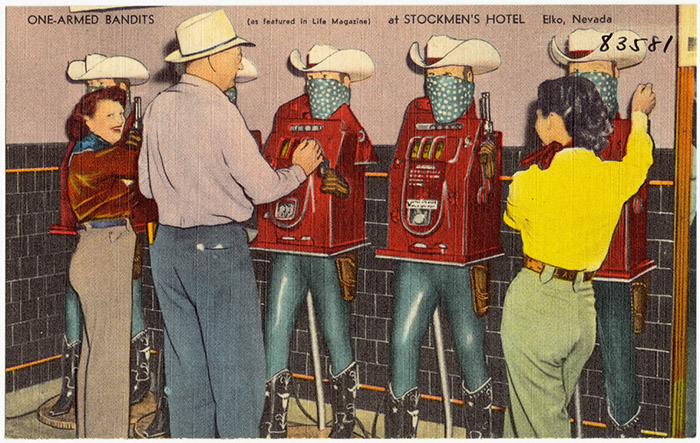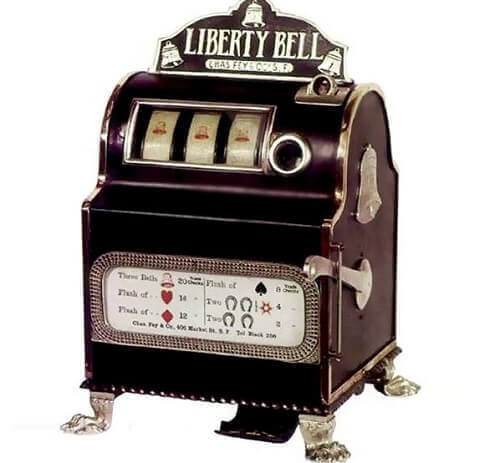Early Caille Slot Machines History
HISTORY OF BALLY SOT MACHINES In 1963 Bally revolutionized the slot machine. It re-introduced a 1941 console slot. That's right, the 1941 Bally Club Bell Console, a three coin multiplier, was in existence in 1941. In 1963 Bally converted the console to a casino slot, refined the hopper payout, and created a front opening case.

Antique Slot Machine Repair and Restoration History
Casino Restorations is a spinoff of a coin operated distributor in St. Paul, MN from the 1930’s until 1960. The doors were closed due to the death of the owner. Parts, tooling and a few machines were moved to new locations and operated from those locations until 1979 when my cherished friend and mentor passed away at the young age of 72.
Everything we had was consolidated to one location where we still operate in St. Paul, MN.
Antique Slot Machine Repair and Restoration Goals
Our goals have always been to do museum quality Antique Slot Machine Repair and Restoration from the late 1800’s into the 1940’s and Penny Arcade Machines and related items from the late 1800’s to 1930’s.
If you have a Machine but have no interest in repair or restoration of it, we would be interested in purchasing it from you.
Antique Slot Machine Repair and Restoration Knowledge

There are very few people in the United States remaining that have the knowledge and skill to properly work on vintage slot machines. There are even fewer companies that do it professionally on a daily basis. Out of those tiny handful of companies, none are corporations that fully insure your machine while in their shop and in transit, handle daily the national transport of antique slot machines or have a full time staff working ONLY ON ANTIQUE SLOT MACHINES; except for Casino Restorations.
With the ever increasing value of antique penny arcade machines, having them worked on by a company with trained staff that have years of experience and will stand behind their work is very important. Also, having a company that knows how to properly restore vintage slots in a factory original way is vital to preserving not only the integrity of the machine, but it’s current and future value.
Proudly Serving
Minnesota, Wisconsin, Iowa, North Dakota, South Dakota
Everyone knows how a slot machine works. You put your money in, pull the lever and hope that the reels match up for the big payout. What you may not know is that the history of slot machines is fascinating and shows just where they’re headed in the future.
The Origin of Slot Machines
The term “slot machine” originally referred to standard vending machines when it was first coined back in the 1880s. The name comes from dropping a nickel into the coin slot to get the product you wanted.
By 1885, the first machines designed for gambling were created, but they bore little resemblance to what we call a slot machine today. These were novelty machines that featured things like toy horses racing around a small track, and patrons of bars and saloons would often bet nickels or tokens that could be redeemed for drinks and cigars.
In 1891 a Brooklyn establishment developed a machine that was closer to what we know today. This machine had five drums, and each drum had 10 different card faces on it, which made it a primitive slot poker machine. Like before, people would put nickels in and get drinks or cigars as prizes based on the hands they won. The 10 of spades and jack of hearts were not included on most machines, which made it harder for people to get a royal flush. A big problem, however, was that automatic payouts were impossible due to a large amount of winning combinations.
History of Slot Machines at the Turn of the 1900s
Early Caille Slot Machines History Today
Finally, in 1894-5, a Bavarian-born San Franciscan named Charles Fey created the “Liberty Bell”, the first true slot machine. This used three spinning reels with five symbols on each. These symbols were the eponymous bells, hearts, spades, diamonds, and horseshoes. The simpler and smaller method allowed automatic payouts of actual cash, and three bells produced the biggest payout of 50 cents. Over 100 of these machines were made, but only four survive today due to the 1906 earthquake and subsequent fire.
Competitors quickly refined the original design. By 1909, they were finding ways to circumvent the bans on slot machines that were being imposed by many states and cities. The card suits were replaced with the now-ubiquitous fruits, and anyone who got three like fruits would win some chewing gum of that flavor.
Most of these early “chewing gum dispensers” didn’t have slots for nickels, and the financial transactions were done over the bar itself. They did, in time, have slots for ejecting chewing gum. The “bar” symbol was developed in 1910, and it was originally a variation on the logo of the Bell-Fruit Gum Company. In 1916, the first true jackpot originated when the Mills Novelty Company developed a way to regurgitate all the machine’s coins with certain reel combinations.
By 1920, however, many states caught on, and even these machines were banned. In 1931, gambling was legalized in Nevada, and slot machines quickly became a top method of making money. By 1951, Nevada was the only state that had legal slot machines, but other states and other countries started having changes of heart because of the amount of money that could be made.

By 1963, the first fully electromechanical slot machine, “Money Honey”, had been invented. This allowed things such as bottomless coin hoppers, automatic payouts of up to 500 coins, and 3- or 5-coin multipliers, allowing extra ways to play and win. In 1976, the first true all-video machines were created, where people could just press a button.
In 1986, the method of linking multiple machines of the same type was developed, allowing higher super jackpots linked to anyone playing on those machines. Improvements in computer technology and random number generation have led to the slots we love today.
Why Are Slots So Popular?
First, they’re designed to make the player seem like they have more control over the game. This is despite the fact that they actually have less control over how they fare than they would with anything else in a casino. There’s no dealer involved, no other players and no one standing by to remind you of what you have to do. There’s just you and the machine.
Second, they’re designed for people to have fun. Unlike card games, which involve a lot of pressure, psychology and personal skill to win, the only thing you have to do is pull the lever or press the button to enjoy the sounds and pictures. If you do manage to win a good amount, you are greeted with bright lights and virtual confetti on top of your winnings.
Third, they’re designed to bring out all of our ideas about luck. Since they are computerized to ensure a completely random outcome, we get to see if crossing our fingers or holding that rabbit’s foot actually means something.
What the Future Holds for Slot Machines
The technology continues to evolve and adapt to new trends in gaming. Millennials are less likely to use slot machines than their elders because they prefer skill to sheer luck. To solve this problem, new skill-based machines are being developed.
As sports betting is expanding, another concept being reviewed is a combination betting machine that would allow players to bet on sports and slots at the same time. Voice controls are also on the horizon for many slot machine manufacturers, and so are machines that accept cryptocurrencies such as Bitcoin.